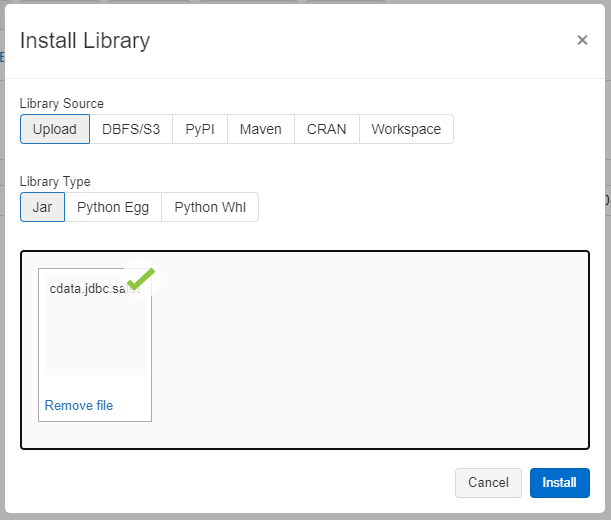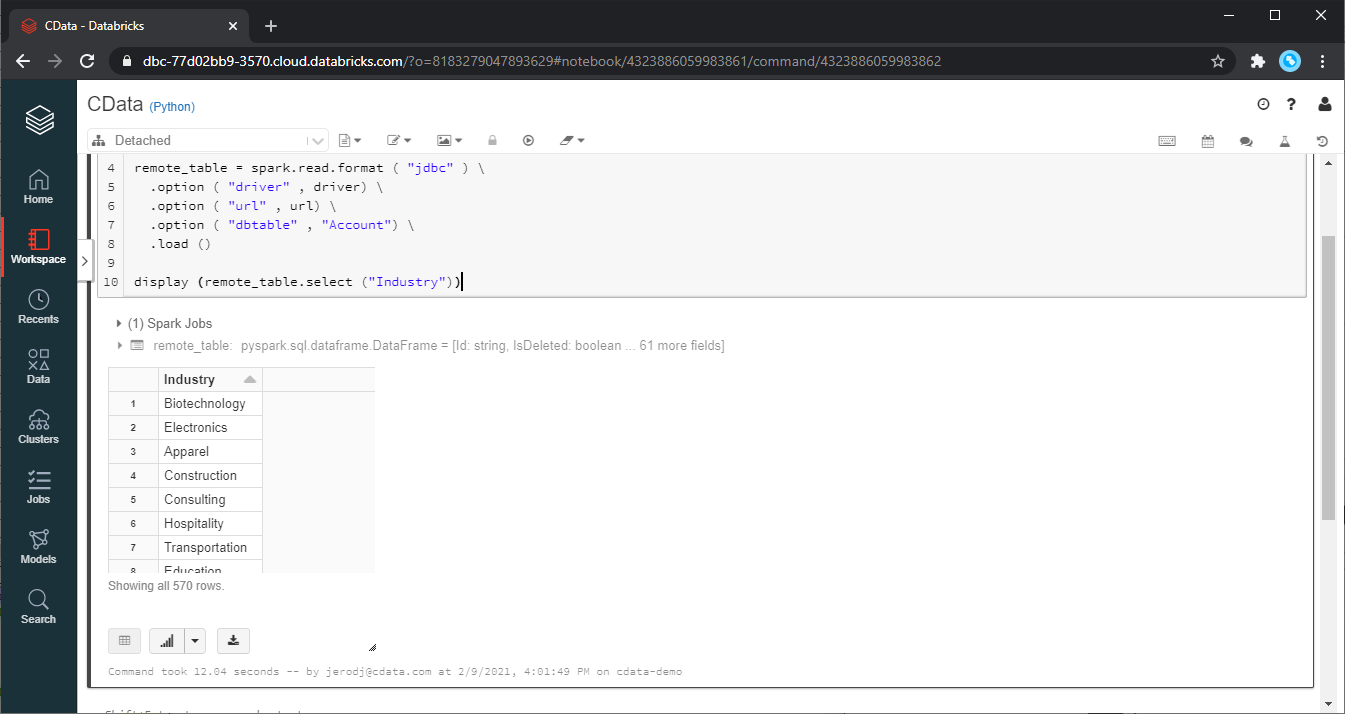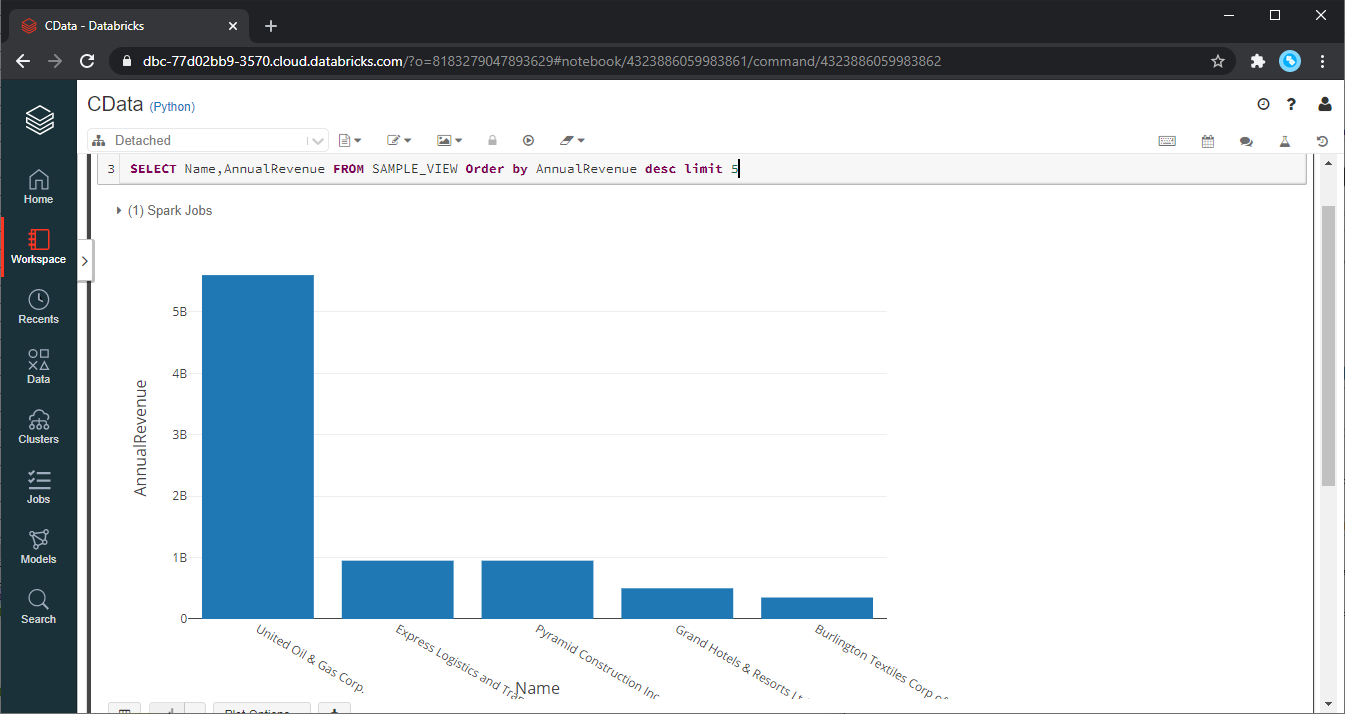Discover how a bimodal integration strategy can address the major data management challenges facing your organization today.
Get the Report →Process & Analyze JSON Services in Databricks (AWS)
Use CData, AWS, and Databricks to perform data engineering and data science on live JSON Services.
Databricks is a cloud-based service that provides data processing capabilities through Apache Spark. When paired with the CData JDBC Driver, customers can use Databricks to perform data engineering and data science on live JSON services. This article walks through hosting the CData JDBC Driver in AWS, as well as connecting to and processing live JSON services in Databricks.
With built-in optimized data processing, the CData JDBC Driver offers unmatched performance for interacting with live JSON services. When you issue complex SQL queries to JSON, the driver pushes supported SQL operations, like filters and aggregations, directly to JSON and utilizes the embedded SQL engine to process unsupported operations client-side (often SQL functions and JOIN operations). Its built-in dynamic metadata querying allows you to work with and analyze JSON services using native data types.
Install the CData JDBC Driver in Databricks
To work with live JSON services in Databricks, install the driver on your Databricks cluster.
- Navigate to your Databricks administration screen and select the target cluster.
- On the Libraries tab, click "Install New."
- Select "Upload" as the Library Source and "Jar" as the Library Type.
- Upload the JDBC JAR file (cdata.jdbc.json.jar) from the installation location (typically C:\Program Files\CData[product_name]\lib).

Access JSON Services in your Notebook: Python
With the JAR file installed, we are ready to work with live JSON services in Databricks. Start by creating a new notebook in your workspace. Name the notebook, select Python as the language (though Scala is available as well), and choose the cluster where you installed the JDBC driver. When the notebook launches, we can configure the connection, query JSON, and create a basic report.
Configure the Connection to JSON
Connect to JSON by referencing the JDBC Driver class and constructing a connection string to use in the JDBC URL. Additionally, you will need to set the RTK property in the JDBC URL (unless you are using a Beta driver). You can view the licensing file included in the installation for information on how to set this property.
Step 1: Connection Information
driver = "cdata.jdbc.json.JSONDriver" url = "jdbc:json:RTK=5246...;URI=C:/people.json;DataModel=Relational;"
Built-in Connection String Designer
For assistance in constructing the JDBC URL, use the connection string designer built into the JSON JDBC Driver. Either double-click the JAR file or execute the jar file from the command-line.
java -jar cdata.jdbc.json.jar
Fill in the connection properties and copy the connection string to the clipboard.
See the Getting Started chapter in the data provider documentation to authenticate to your data source: The data provider models JSON APIs as bidirectional database tables and JSON files as read-only views (local files, files stored on popular cloud services, and FTP servers). The major authentication schemes are supported, including HTTP Basic, Digest, NTLM, OAuth, and FTP. See the Getting Started chapter in the data provider documentation for authentication guides.
After setting the URI and providing any authentication values, set DataModel to more closely match the data representation to the structure of your data.
The DataModel property is the controlling property over how your data is represented into tables and toggles the following basic configurations.
- Document (default): Model a top-level, document view of your JSON data. The data provider returns nested elements as aggregates of data.
- FlattenedDocuments: Implicitly join nested documents and their parents into a single table.
- Relational: Return individual, related tables from hierarchical data. The tables contain a primary key and a foreign key that links to the parent document.
See the Modeling JSON Data chapter for more information on configuring the relational representation. You will also find the sample data used in the following examples. The data includes entries for people, the cars they own, and various maintenance services performed on those cars.

Load JSON Services
Once you configure the connection, you can load JSON services as a dataframe using the CData JDBC Driver and the connection information.
Step 2: Reading the data
remote_table = spark.read.format ( "jdbc" ) \ .option ( "driver" , driver) \ .option ( "url" , url) \ .option ( "dbtable" , "people") \ .load ()
Display JSON Services
Check the loaded JSON services by calling the display function.
Step 3: Checking the result
display (remote_table.select ("[ personal.name.first ]"))

Analyze JSON Services in Databricks
If you want to process data with Databricks SparkSQL, register the loaded data as a Temp View.
Step 4: Create a view or table
remote_table.createOrReplaceTempView ( "SAMPLE_VIEW" )
With the Temp View created, you can use SparkSQL to retrieve the JSON services for reporting, visualization, and analysis.
% sql SELECT [ personal.name.first ], [ personal.name.last ] FROM SAMPLE_VIEW ORDER BY [ personal.name.last ] DESC LIMIT 5

The data from JSON is only available in the target notebook. If you want to use it with other users, save it as a table.
remote_table.write.format ( "parquet" ) .saveAsTable ( "SAMPLE_TABLE" )
Download a free, 30-day trial of the CData JDBC Driver for JSON and start working with your live JSON services in Databricks. Reach out to our Support Team if you have any questions.






